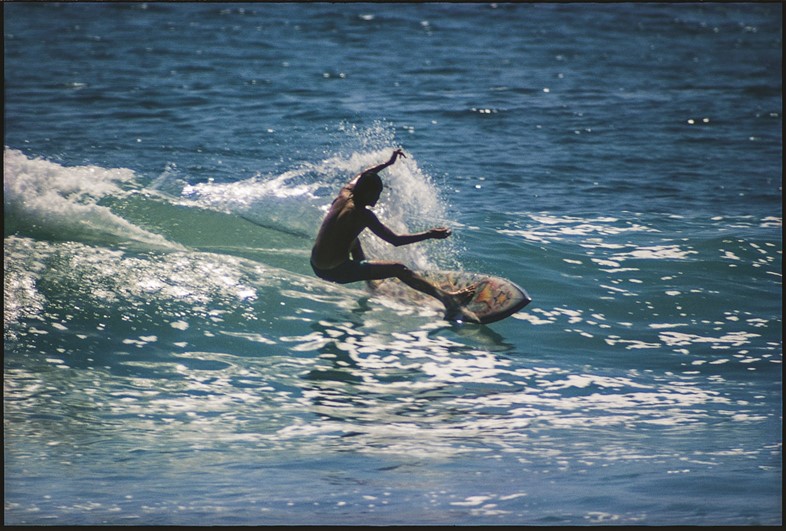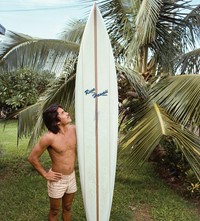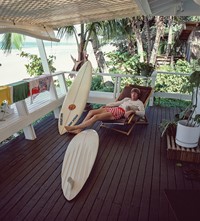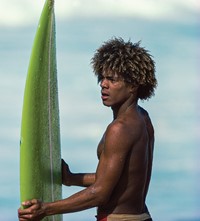Photographer Jeff Divine shares his memories of surfing in the 1970s, as his new book is published
- TextMiss Rosen
Hailing from San Diego, California, Jeff Divine took up surfing in 1964 when he was 14. Two years later he bought a camera, and the rest is history. For the next 35 years, he worked as a photo editor with Surfer magazine, the bible of the sport, and Surfer’s Journal, documenting the then-nascent surf scene long before it became a global phenomenon.
With the March 10 publication of Jeff Divine: 70s Surf Photographs, we travel back in time to the golden age of surfing. In Divine’s sumptuous colour and black and white photographs, we join bands of teenage boys as they invent the culture and the sport that would soon take the world by storm. “We were so addicted to surfing. It was so deep in our psyche, like nothing else mattered,” Divine tells Another Man. Here, the photographer shares his memories of life riding the wave.
“We had our own little wilderness world in La Jolla, North County San Diego, and Mexico where we had our own names for everything. Society didn’t get it. We weren’t bad boys – we were wilderness athletes. We were apolitical but we had that back to Mother Nature, health foods, we’re all one psychedelic mindset of the late 1960s and 70s.
“Surfing in California is very regional. Coastal enclaves a few miles apart will have a distinct group of guys. In San Diego, we were off the radar because the centre was Dana Point – John Severson started Surfer magazine there in 1962. I started coming to the office in 1968, 69. I was shy and thrust into Surfer, which was the centre of the surfing universe. It started getting newsstand sales, which was a really big deal. By 1971, it had a circulation of 60,000 and for every one magazine, the hand around rate was six times. That’s a lot of people checking it out.
“I photographed surfing for 50 years and was exposed to so many good surfers, from Gerry Lopez at Pipeline to Kelly Slater. As a photographer, what attracted me to certain surfers is a certain body style where they really threw their weight into their bottom turn on the surfboard and go straight up the face of the wave then do a snap off the top. You always knew they were going to do something good. A lot of them you had to track them down. Early on you had to get them in your car and go with them. It was like herding cats.

“We’d go barefoot. Surfers don’t care. If you give a surfer a box of clothes, that’s what he’s going to wear. It was very utilitarian. Our fashion thing was more found and original depending on the personality of the surfer. We’d go to Baja and get those embroidered Mexican wedding shirts on the way home. You could look at surfers and tell where they had been: a necklace from Bali or something from France. In those days, the top stylish guy held his hands in a certain way, like bullfighter type poses. On land they were heroes too because of what they wore and how they walked. Some went to Spain to study flamenco guitar.
“Things were simple. There was no money. It was you, your board, your buddies, and a brown bag. All I remember is maybe having an apple, banana, or PB&J. We didn’t care. We never thought about it at all. You’d drape your towel off your board to walk to the beach and you didn’t have anything else. Once we got our driving licenses it opened things. When you got in your car you were on the wilderness trail and you could go to Santa Barbara or Mexico.
“We had so much fun. Guys would take acid and surf naked. We would drive down the beach to a secluded area, put speakers out, play Santana and smoke weed and laugh. We were outdoors men. We’d go out to La Jolla and a fog bank would come in and you can’t see. Then it pushes away and it’s a bright sunny day and there’s a dolphin pod and pelicans come swooping at you. You could be on a wave with a dolphin. When I’d go home to my parents and you couldn’t even describe it. It was like a secret world.”
Jeff Divine: 70s Surf Photographs is published by T. Adler Books.















